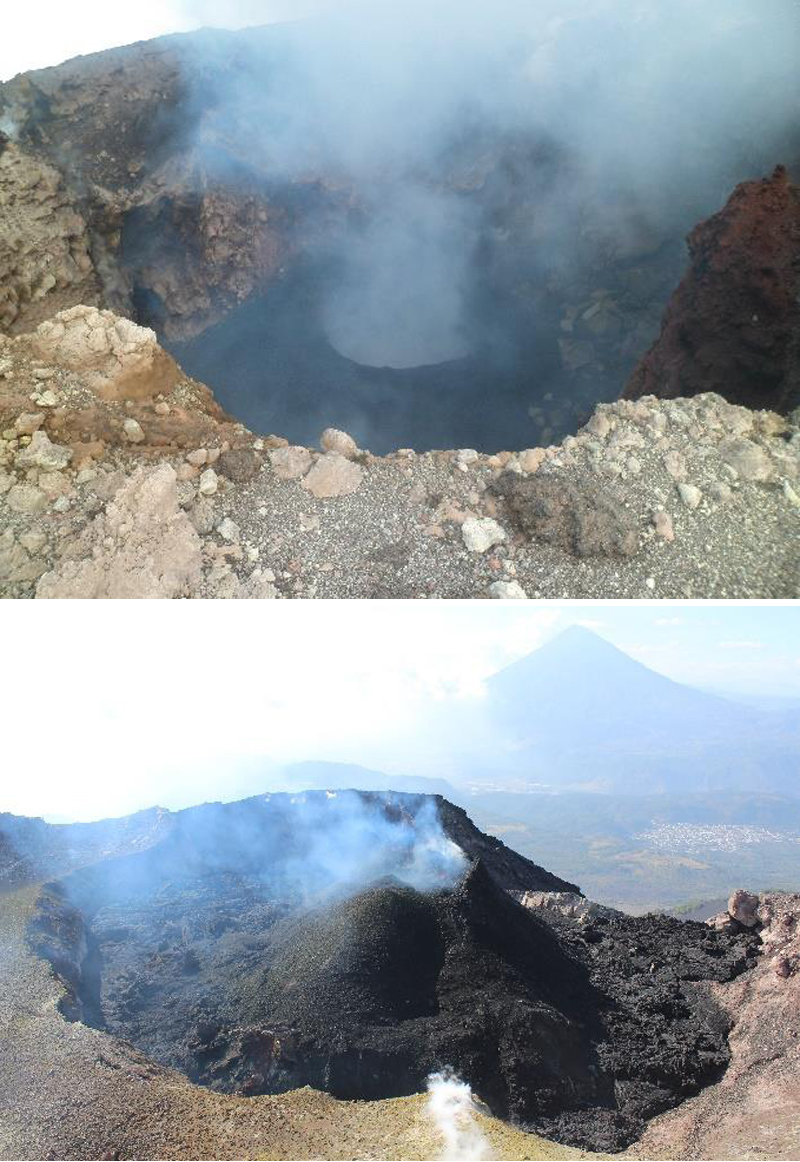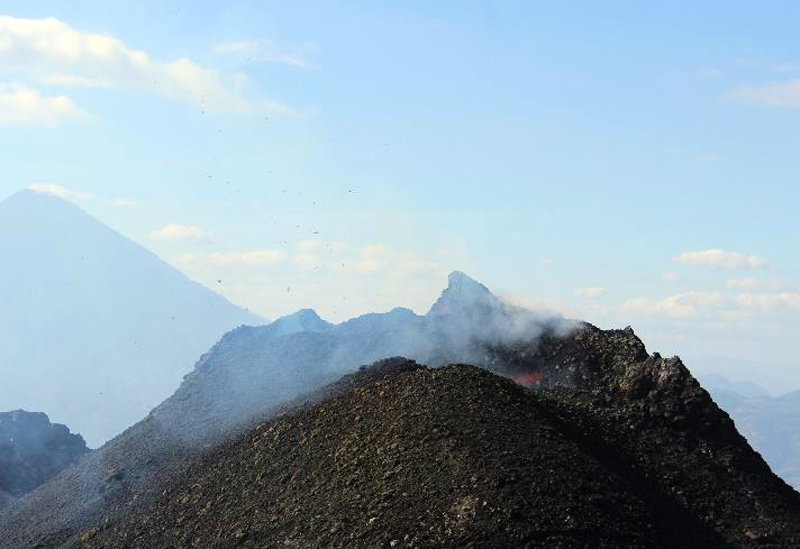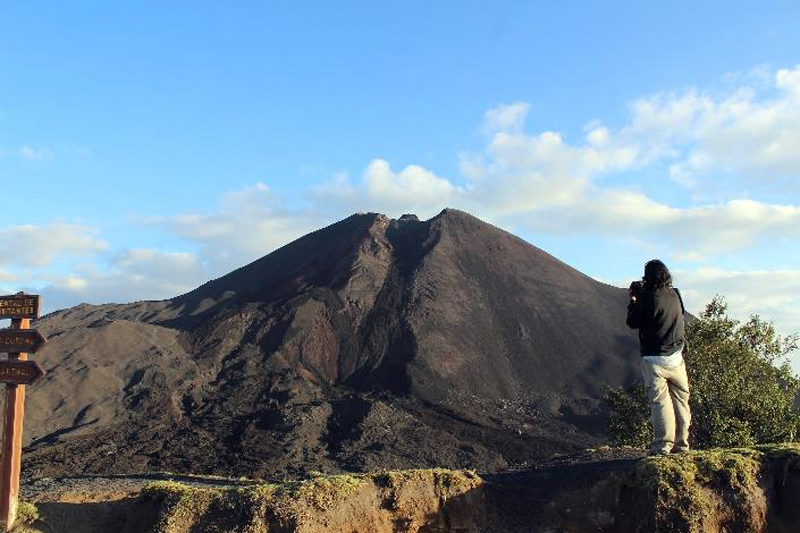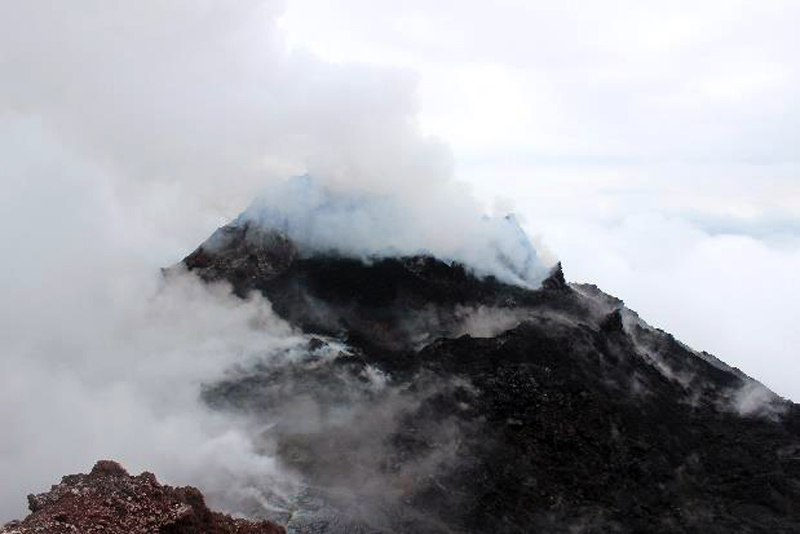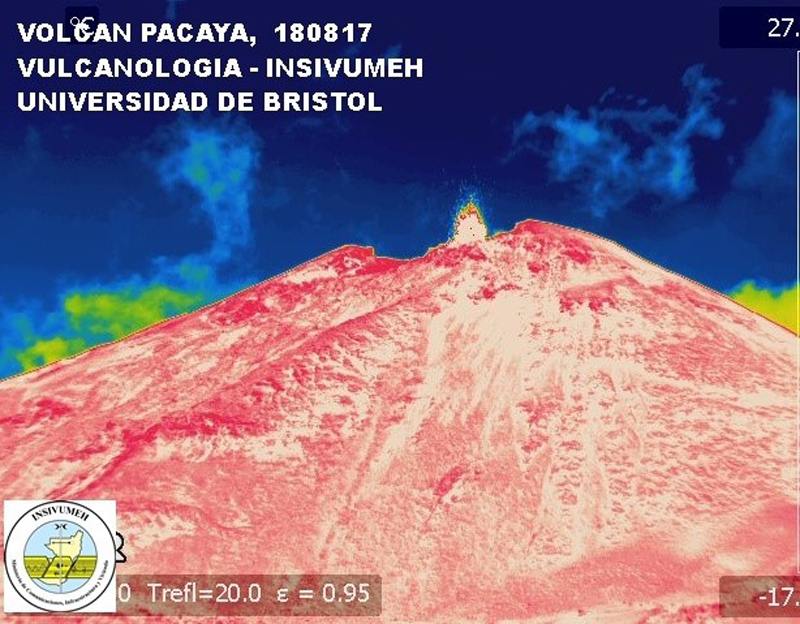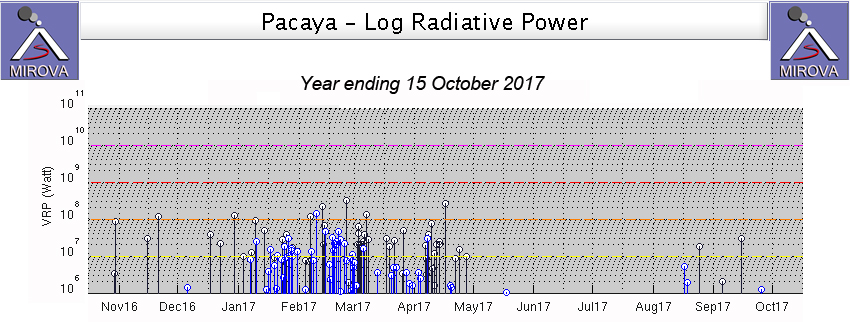Report on Pacaya (Guatemala) — December 2017
Bulletin of the Global Volcanism Network, vol. 42, no. 12 (December 2017)
Managing Editor: Edward Venzke.
Edited by A. Elizabeth Crafford.
Pacaya (Guatemala) Pyroclastic cone in MacKenney crater grows above crater rim, January-September 2017
Please cite this report as:
Global Volcanism Program, 2017. Report on Pacaya (Guatemala) (Crafford, A.E., and Venzke, E., eds.). Bulletin of the Global Volcanism Network, 42:12. Smithsonian Institution. https://doi.org/10.5479/si.GVP.BGVN201712-342110
Pacaya
Guatemala
14.382°N, 90.601°W; summit elev. 2569 m
All times are local (unless otherwise noted)
Activity since 1961 at Pacaya has been characterized by extensive lava flows, bomb-laden Strombolian explosions, and ash plumes emerging from MacKenney crater and several vent fissures, impacting communities in the vicinity; several million people live within 50 km. After a few months of quiet, intermittent ash plumes and incandescence in early June 2015 marked the beginning of the latest eruptive episode, which has been ongoing since that time. Observations of incandescence increased during the second half of 2015, and the presence of a new pyroclastic cone, about 15 m in diameter at the center of MacKenney crater, was confirmed in mid-December 2015.
Strombolian activity from the cone continued throughout 2016. It was most active during June and July, depositing new ejecta onto the flanks. Although it had quieted down by the end of the year, persistent degassing, steam plumes, and occasional incandescence were still observed from the new cone. It had filled much of the crater by December 2016. This report describes the continued growth of the pyroclastic cone during January-September 2017, as well as new lava flows that emerged during February and March. Information was provided primarily by the Instituto Nacional de Sismologia, Vulcanologia, Meteorologia e Hydrologia (INSIVUMEH) and satellite thermal data.
The pyroclastic cone inside MacKenney crater continued to grow sporadically during January-September 2017. Weak explosions in January produced ejecta 15 m above the top of the cone as steam and gas emissions rose about 400 m above the crater rim. By early February the top of the cone had risen to 10 m above the crater rim. Ejecta ranging in size from millimeters to 50 cm rose up to 25 m above the cone. Three small lava flows emerged from the crater in early February and flowed down the NW flank a few hundred meters before cooling. Growth of the cone continued more slowly during March-August, but incandescence was still observed, and weak explosions deposited tephra around the sides of the cone. Increased explosive activity during August reduced the height of the cone to slightly below the crater rim, but renewed explosions during September built it back up again to 10 m above the rim a few weeks later.
During January 2017, activity increased slightly compared with December 2016, and included degassing, tremors, incandescence, and weak explosions from MacKenney crater. Steam-and-gas plumes rose to around 400 m above the crater rim and generally drifted about 5 km before dissipating. Incandescence in the crater grew more visible towards the end of the month; ejecta from the pyroclastic cone within crater rose as much as 15 m above the crater rim. Seismic RSAM values also increased from a maximum of 2,500 to 3,500 units. The first MODVOLC thermal alert since 10 April 2016 appeared on 10 January 2017. Eight more alerts appeared during January, every few days for the rest of the month.
Degassing during February 2017 sent plumes slightly higher to 500 m above the crater . The top of the pyroclastic cone had risen to about 10 m above the crater rim by early February, as compared to about 10 m below the crater rim a year earlier in February 2016 (figure 78). Ejecta from the cone ranged in size from millimeters to 50 cm, and rose to heights of 10-25 m above the top of the cone with constant activity (figure 79).
Three small lava flows were reported during February 2017, first emerging from the NW side of the crater from the fissure created during 2010 on 9 February 2017 and flowing NW towards Cerro Chino. Incandescent material was ejected 30-50 m above the crater rim and filled much of the crater. Lava travelled as far as 300 m down the NW flank. The dimensions of the flows were variable, but by the end of the month they were about 50 m long and 20 m wide. Ten MODVOLC thermal alerts were issued during February, indicating that activity was high inside and around the summit crater.
Steam plumes during March and April 2017 rose as high as 600 m above the crater rim. Lava flowed tens of meters outside the crater rim a few times at the end of March. The growth of the pyroclastic cone continued with Strombolian explosions of 10-25 m above the top of the cone during this time, and incandescence visible on clear nights. It was possible to see the new cone above the crater rim from the NW and W flanks (figure 80). Rumblings from the explosive activity were reported within 5 km of the cone. Although the three MODVOLC thermal alerts issued during the first week of March were the last through at least September 2017, weak explosions and nighttime incandescence continued during May as the pyroclastic cone continued to grow.
By June 2017, the steam plumes were rising about 800 m above the crater rim. The height of the pyroclastic cone remained at about 10 m above the crater rim, but continued to grow in volume and produce abundant steam and gas (figure 81). Similar emissions were reported during July, however, incandescence was only occasionally observed at night.
INSIVUMEH reported increased activity during August 2017 with the frequency of Strombolian explosions increasing to 5-7 per hour, and higher RSAM units recorded to 4,000; some material was ejected as high as 75 m above the crater rim, generating block avalanches as far as 100 m down the W flank. Explosions during 11 August reduced the height of the pyroclastic cone inside the crater such that it was no longer visible from the flank. Moderate to strong explosions were recorded a number of times during the month (figure 82).
Seismic and explosive activity remained high during September 2017. Two significant events were recorded. On 5 September RSAM values peaked at 5,000 units and remained elevated for about six hours before dropping back to average values around 2,000. This corresponded with a period of rebuilding of the pyroclastic cone within the crater. INSIVUMEH reported Strombolian explosions ejecting material as high as 100 m above the crater rim during 21-22 September. The second event lasted for about three days during 23 and 26 September when there was an increase in the rate of explosions, registering up to 40 per hour. After destruction of part of the cone during August, it was rebuilt to a level about 10 m above the crater rim again during this time.
Infrared thermal data generally agrees well with observations of increased activity and lava flows during January-March 2017 (figure 83). However, reports from INSIVUMEH indicate that explosive activity continued at the pyroclastic cone during April-September, although only the largest events during August and September created thermal signals that were captured in the MIROVA data.
Geological Summary. Eruptions from Pacaya are frequently visible from Guatemala City, the nation's capital. This complex basaltic volcano was constructed just outside the southern topographic rim of the 14 x 16 km Pleistocene Amatitlán caldera. A cluster of dacitic lava domes occupies the southern caldera floor. The post-caldera Pacaya massif includes the older Pacaya Viejo and Cerro Grande stratovolcanoes and the currently active Mackenney stratovolcano. Collapse of Pacaya Viejo between 600 and 1,500 years ago produced a debris-avalanche deposit that extends 25 km onto the Pacific coastal plain and left an arcuate scarp inside which the modern Pacaya volcano (Mackenney cone) grew. The NW-flank Cerro Chino crater was last active in the 19th century. During the past several decades, activity has consisted of frequent Strombolian eruptions with intermittent lava flow extrusion that has partially filled in the caldera moat and covered the flanks of Mackenney cone, punctuated by occasional larger explosive eruptions that partially destroy the summit.
Information Contacts: Instituto Nacional de Sismologia, Vulcanologia, Meteorologia e Hydrologia (INSIVUMEH), Unit of Volcanology, Geologic Department of Investigation and Services, 7a Av. 14-57, Zona 13, Guatemala City, Guatemala (URL: http://www.insivumeh.gob.gt/); MIROVA (Middle InfraRed Observation of Volcanic Activity), a collaborative project between the Universities of Turin and Florence (Italy) supported by the Centre for Volcanic Risk of the Italian Civil Protection Department (URL: http://www.mirovaweb.it/); Hawai'i Institute of Geophysics and Planetology (HIGP), MODVOLC Thermal Alerts System, School of Ocean and Earth Science and Technology (SOEST), Univ. of Hawai'i, 2525 Correa Road, Honolulu, HI 96822, USA (URL: http://modis.higp.hawaii.edu/).


